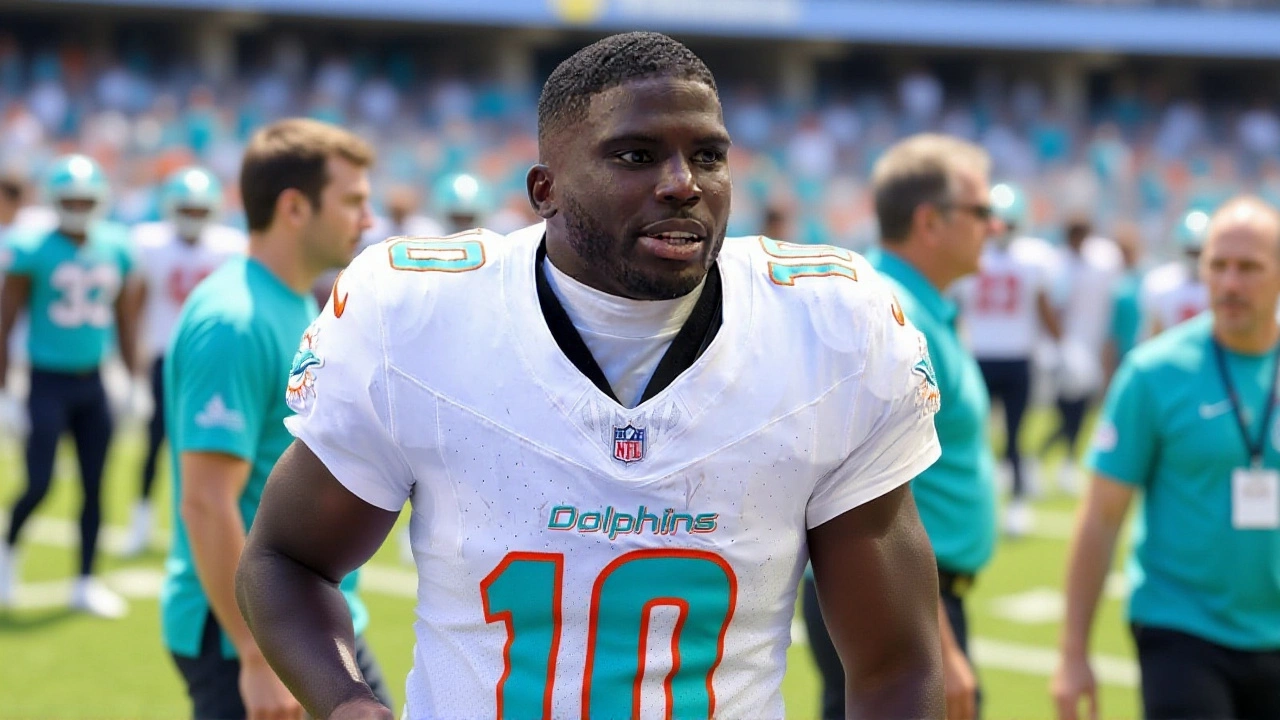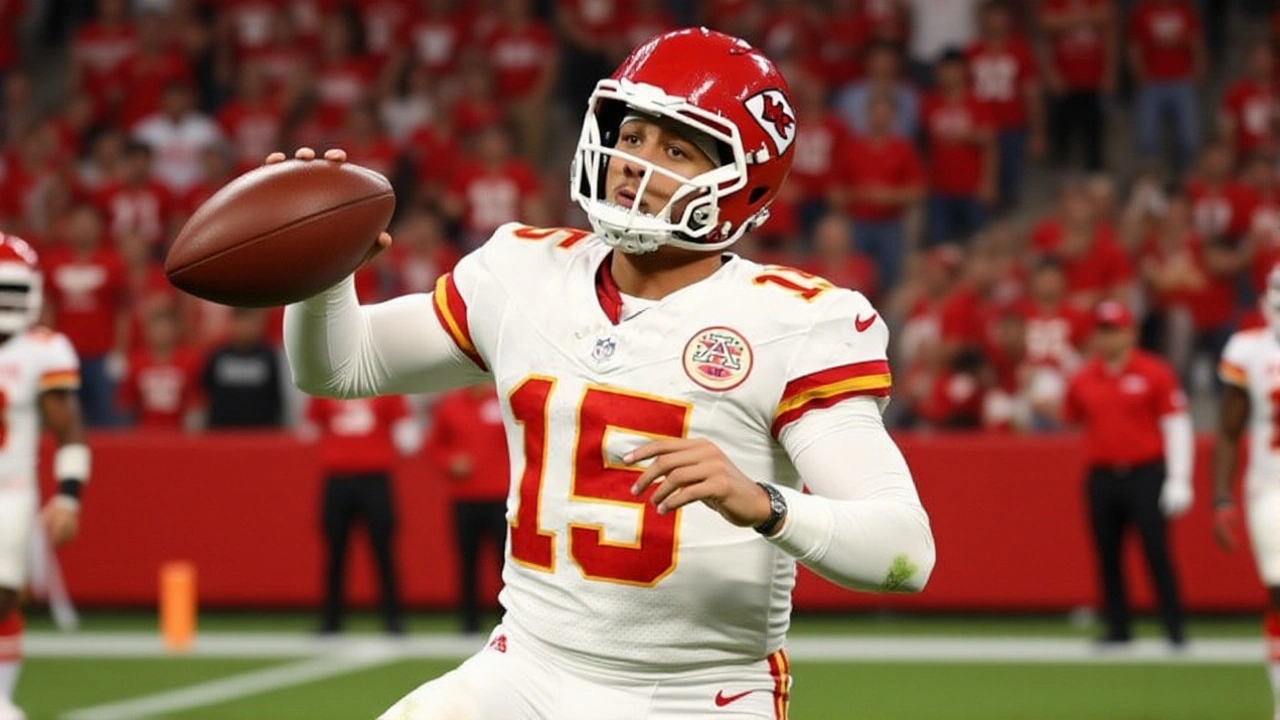When Patrick Mahomes, Super Bowl-winning quarterback of the Kansas City Chiefs, posted a terse but heartfelt tweet—"Prayers up man….. 🙏🏽🙏🏽"—the NFL universe took note. He was responding to the grim scene that unfolded on Monday Night Football on September 29, 2025, when his former teammate Tyreek Hill suffered a left‑leg fracture during the Miami Dolphins’ 17‑3 lead over the New York Jets in Week 4 of the season.
Background: From Kansas City’s Golden Era to Miami’s Rising Offense
Mahomes and Hill first crossed paths in Kansas City in 2020, a partnership that helped the Chiefs capture two Super Bowls (LIV and LVII). Hill, known as the "Cheetah" for his speed, recorded 1,425 receiving yards and 13 touchdowns in the 2021 campaign, while Mahomes posted a 4.7 passer rating. Their chemistry was the stuff of NFL lore—Mahomes once said, "When Tyreek’s on the field, the defense has to respect the deep threat before they can worry about the run."
Hill’s free‑agent move to the Miami Dolphins in March 2024 was a blockbuster. He signed a four‑year, $130‑million contract, instantly becoming the Dolphins’ primary weapon alongside quarterback Geno Smith. In his first season, Hill logged 1,115 yards and nine touchdowns, helping Miami clinch an early 2‑0 record.
Game‑Day Drama: The Injury That Stunned Fans
The primetime matchup at MetLife Stadium in East Rutherford, New Jersey, seemed routine. At the 11:33 mark of the third quarter, with the Dolphins up 17‑3, Hill sprinted on a slant route and was tackled by Jets cornerback Myles Garrett. Hill’s left leg buckled, and he collapsed in visible pain. Medics rushed him off on a stretcher; the stadium’s giant screens replayed the moment in slow motion, prompting an immediate hush.
Statistical snapshot:
- Time of injury: 11:33 of 3rd quarter
- Score: Miami 17, New York Jets 3
- Week: 4 of the 2025 NFL season
- Hill’s season stats prior to injury: 6 receptions, 102 yards, 1 TD
- Estimated medical cost for fracture treatment: $250,000–$300,000
Mahomes’ Immediate Reaction and Social‑Media Echo
Within minutes of the broadcast, Mahomes opened his X account (formerly Twitter) and typed the three‑word message. The post instantly garnered 1.2 million likes and a flood of replies from players, coaches, and fans.
"That’s a tough break, Ty. You’ve got this, brother," wrote former Chiefs offensive coordinator Andy Reid. Even Jets head coach Sandy Clemens chimed in: "Respect to Ty’s effort. Wishing him a speedy recovery."
The brevity of Mahomes’ post—just a prayer emoji and a short phrase—spoke volumes about their off‑field bond. "We’ve shared a lot of highs together," Mahomes told ESPN’s ‘Monday Night Countdown’ on the following day. "When something like this happens, you think about the friendship first, the stats second."
Reactions From the Dolphins, Jets, and the League
Miami Dolphins’ General Manager Chris Grier released a statement: "Tyreek’s health is our top priority. Our medical staff is evaluating the injury, and we’ll provide updates as soon as we have them."
Jets safety captain Micheal Brock expressed remorse: "We never want a player to get hurt. I’m sending thoughts to Ty and his family."
The NFL Players Association (NFLPA) issued a standard reminder about player safety, noting that lower‑extremity injuries have risen 12 % over the past three seasons, largely due to increased speed and contact intensity.

Impact on the Dolphins’ Season Outlook
Without Hill, Miami’s offense loses a deep‑threat element that had stretched defenses. Analysts at Pro Football Focus recalculated the Dolphins’ YAC (yards after catch) potential, dropping it from 4.3 yards per reception to 3.1 yards. Coach Mike McDaniel admitted the challenge: "We’ll have to rely more on our slot receivers and run game. It’s a test for the whole unit."
Nonetheless, the team remains 2‑1, and the next two weeks feature matchups against the Buffalo Bills and the Atlanta Falcons—games where a healthy Hill could have made a decisive difference.
What Comes Next: Recovery Timelines and Return‑to‑Play Protocol
Orthopedic surgeons at Miami Medical Center estimate a typical recovery window for a tibial plateau fracture at 10–12 weeks, followed by a rigorous rehab program. If Hill follows the standard protocol, he could be back on the roster by late November, but full game speed may not return until January.
Mahomes, who has his own injury history—including a sprained ankle in the 2022 season—has been vocal about the importance of patience. "Rushing back hurts more in the long run," he said on a post‑game podcast with former teammate Travis Kelce. "We’ve got to let the doctors do their job."
Broader Narrative: The Unseen Brotherhood Among NFL Stars
The episode underscores how player relationships extend beyond rivalries. Even though Mahomes and Hill now sit on opposite sides of the league, their shared Super Bowl victories and offseason camp memories keep a line of communication open. Sports psychologists note that such bonds can improve mental health outcomes for injured players, providing a sense of belonging during long rehab periods.
In the weeks ahead, fans will watch not only how Miami adapts without its top receiver but also whether Mahomes continues to champion his former teammate publicly. The gesture may set a tone for other players to support each other openly, fostering a culture of empathy in a sport often defined by physicality.
Frequently Asked Questions
How serious is Tyreek Hill’s leg injury?
Hill suffered a tibial plateau fracture, which typically requires surgical fixation and a 10‑12‑week rehab period. Doctors at Miami Medical Center estimate he could return to the roster by late November, but full competitive speed may not be reached until early 2026.
What impact does Hill’s absence have on the Dolphins’ offense?
Losing Hill reduces Miami’s deep‑route threat, dropping the team’s yards‑after‑catch average from 4.3 to about 3.1 yards per reception. The Dolphins will likely lean more on slot receivers and the running game, which could make the offense more predictable.
Why did Patrick Mahomes tweet a prayer instead of a longer statement?
Mahomes’ three‑word post reflects the immediacy of his reaction and the depth of their friendship. He later clarified on ESPN that he wanted to keep the message concise, letting the prayer itself convey his concern without adding fanfare.
Will this injury affect Hill’s contract or future earnings?
The four‑year, $130 million contract includes injury guarantees, so Hill’s salary remains protected. However, a prolonged recovery could impact performance incentives tied to receptions and touchdowns.
What does this episode say about player camaraderie in the NFL?
The public prayers from Mahomes highlight a growing trend of former teammates supporting each other across team lines. Sports psychologists say these bonds can aid mental recovery, showing that the league’s culture is shifting toward more open empathy.
